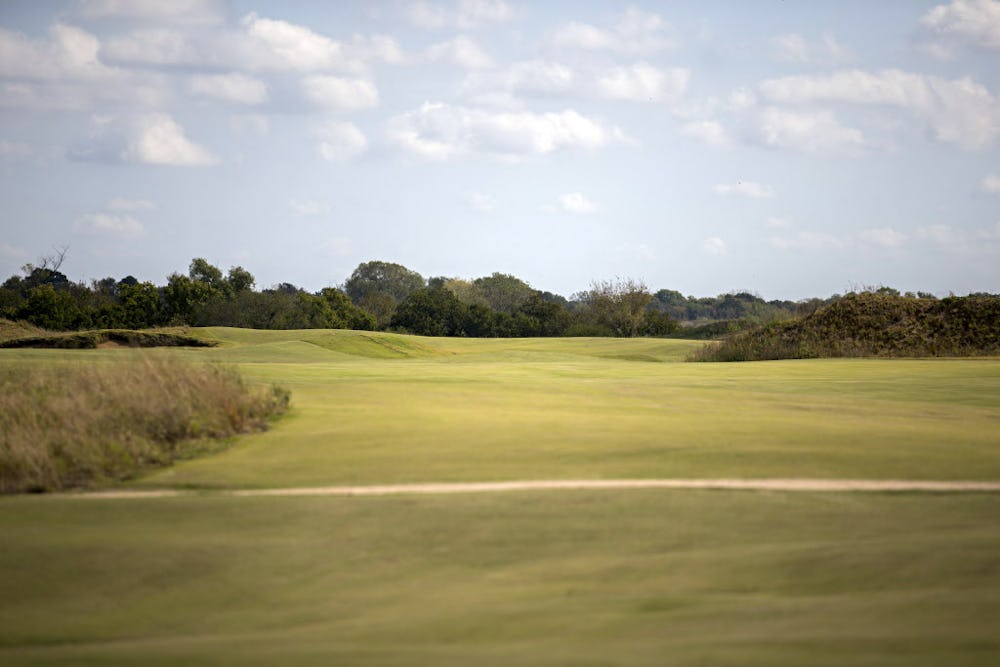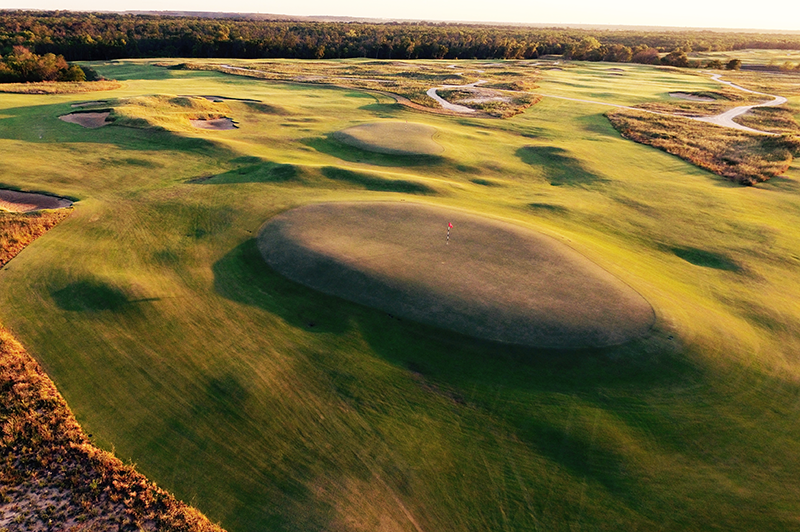When you come to think of it that is the secret of most of the great holes all over the world. They all have some kind of a twist. C.B. MACDONALD
Cypress Point Hosting...A College Golf Tournament Again
/Trinity Forest Opening Photos, A Few Course Glimpses
/G.J. McCarthy's photo gallery for the Dallas Morning News offers a few more glimpses of the new Trinity Forest course in Dallas. Designed by Bill Coore & Ben Crenshaw, the course was built on a 400-acre landfill and sports a $150,000 initiation fee. 
The layout measures 7,300 yards from the tips and plays to a par of 71 with 11 par-4s, four par-3s and three par-5s. Three holes cross a deep ravine, and three others have split fairways. Most of the greens are slightly elevated with tightly mowed surrounding areas.
This Instagram image from Jordan Spieth gives a sense of the course location and scale:
Trinity Forest To Host Nelson Year Earlier Than Planned
/The Coore-Crenshaw design, opening this weekend and reportedly considered a potential future major venue, will host the 2018 AT&T Byron Nelson. That is a year earlier than expected, ending the PGA Tour's run at Las Colinas (since 1983) this upcoming season. Art Stricklin reports the announcement will be made Wednesday with Jordan Spieth, PGA Tour EVP Andy Pazder.
Art Stricklin reports the announcement will be made Wednesday with Jordan Spieth, PGA Tour EVP Andy Pazder.
Salesmanship Club officials said the early move came about for two reasons: The club and the Tour came to an agreement with the Four Seasons Resorts owner, Blackstone Real Estate Advisors, to get out of the contract early and the Tour's agronomy staff has signed off on when the course could host its first professional event.
Translation: they couldn't get away from TPC Las Colinas fast enough.
You can see a few Trinity Forest images at their official site.
"Possibilities abound for South Shore-Jackson Park golf course"
/The Chicago Tribune's Teddy Greenstein considers the possible South Shore-Jackson Park-Obama-Woods-Keiser-Rolfing project on the South Side and gives it an endorsement, seeing plenty of potential "greatness," assuming green fees for the locals do not go up substantially.The project has been a dream of Rolfing's that has taken an intriguing turn with the possible inclusion of Tiger Woods and now, the Obama library. I hate seeing the dreadful TPC Harding Park redesign--a massive cost overrun boondoggle with dreadful architectural results--as a precedent setter, but Greenstein notes the green fees have at least held steady:
That's what officials did at TPC Harding Park, the San Francisco course that was transformed into a facility worthy of the 2009 Presidents Cup. Senior residents of the city can play the 18 holes from Monday-Thursday for $39, about one-fourth of the standard rate.
Rolfing also wants to design a "short course" in the vein of what Harding Park has — nine holes ranging from 140-405 yards
Now Available: Long-Awaited Tom Simpson Biography
/Chambers To Get Boutique Hotel It Needs To Land Another Major
/Brynn Grimley reports on the selection of a local team to build a resort-style hotel, restaurant and villas at Chambers Bay. While getting the turf a little stronger is a priority for some and stadium mounds that actually work (unlike the ones RTJ envisioned), we all know by now the real key to landing a repeat major centers around high-end lodging for the decision-makers.
This should help:
Led by Dan and Tom Absher, of Puyallup-based Absher Construction, and Dan Putnam, who previously was CEO of structural engineering firm PCS Structural Solutions, Chambers Bay Development used the local angle in its pitch. Also included is Columbia Hospitality, Kemper Sports, GGLO Architects and Douglas.
Putnam and the Abshers say they view the project as a legacy, something they would remain a part of after construction.
“I think they understand the Pacific Northwest,” said county Parks and Recreation director Tony Tipton. “The end product will transform into something this community can be proud of.”
The plans are conceptual, which means architectural features and smaller details are likely change as the project moves through the permitting process.
Trending: Sand Coming (Back) To St. Andrews!
/We saw it at Troon and Turnberry and the world continued to revolve on its axis. So it is with great delight that Adam Lawrence reports on a New Course at St. Andrews effort to remove the gorse that so annoyed Old Tom Morris, and restore it to the sandy/grassy aesthetic of old.
 This news is fun on multiple levels: this makes for a better looking course, better playing and better functioning. And what happens in St. Andrews has the potential to influence countless other links that have been compromised by gorse and the loss of dunes.
This news is fun on multiple levels: this makes for a better looking course, better playing and better functioning. And what happens in St. Andrews has the potential to influence countless other links that have been compromised by gorse and the loss of dunes.
Lawrence quotes Graeme Taylor, course manager for the New and Jubilee.
Taylor told GCA that the reason for converting the gorse areas back to exposed sand was primarily ecological. “Bob Taylor, our ecologist from the Sports Turf Research Institute, actaully first suggested the exposed sand areas back in 2005,” he explained. “Bob explained that exposed sand was a habitat common to linksland and was ecologically important. We tried a few areas then, but nothing like the scale of what we are now doing. Bob visited us again after last year’s Open, and again suggested that creating open sand areas would be very beneficial ecologically, restore natural habitats, and be an interesting feature to otherwise scruffy areas.”
The news of an architect's involvement at St. Andrews is also intriguing given Ebert's fine work at Turnberry, Troon and presumably based on the track record of he and partner Tom Mackenzie, Portrush.
Could this be leading to a consulting role for The Old Course? Given the many disappointing tweaks in recent times and the overabundance of gorse that would have Old Tom fuming, let's hope so.
Quaker Ridge Wins Errant Golf Ball Case
/Harbour Town Not Looking Good After Matthew
/Hilton Head Island
RIP Sheep Ranch, Hello Fifth Bandon Course
/Today In The Tiger Rumor Mill: Buying Taylor Made And Restoring A South Shore Course For Free?
/"Proposal suggests revamped Yale golf course"
/Daniela Brighenti reports that Yale University and the city of New Haven have a proposal before them by Yale grad Roland Betts to transform the Country Club of Woodbridge and restore the Yale University course. As you can see from Ran Morrissett's 2008 profile of Yale, the CB Macdonald, Seth Raynor design could be one of the world's great courses with a full restoration.
As you can see from Ran Morrissett's 2008 profile of Yale, the CB Macdonald, Seth Raynor design could be one of the world's great courses with a full restoration.
The plan would also include a partnership with the University in which Redan would restore and operate the Course at Yale as well as construct a lodging facility of approximately 80 rooms on its nearby land. According to the proposal, hotel operations would be provided by The Study in New Haven.
“The Redan Reserve concept is an intriguing one that is of significant interest to our Board of Selectmen and many of our residents,” Woodbridge First Selectman Ellen Scalettar said. “[Woodbridge] awaits news from Redan Reserve regarding Yale’s interest — and the city of New Haven’s interest — in the Redan Reserve project.”
According to Redan’s proposal, which is expected to cost $3.5 million, the restoration of the Course at Yale would be “faithful” to its original, historic design, while the revamped course in Woodbridge would be “entirely modern and unique.” Both courses would be open to the general public and built with the explicit intention of being ranked among the top 100 courses in the world, according to the proposal for the course.
America's Closest-To-Perfection Course Designs
/I was asked to put the emphasis on design for this slideshow at GolfDigest.com and went a little snobbish in pursuit of highlighting perfection.
 In thinking about some of America's best and pouring over rankings, restorations and thoughts of their architects, I was astounded by how many elite courses have well-documented design flaws or are living off their reputation as merely difficult-to-play. (It was also amazing to consider how many Macdonald-Raynor designs have seen restorations take them to places maybe never even imagined by their creators.)
In thinking about some of America's best and pouring over rankings, restorations and thoughts of their architects, I was astounded by how many elite courses have well-documented design flaws or are living off their reputation as merely difficult-to-play. (It was also amazing to consider how many Macdonald-Raynor designs have seen restorations take them to places maybe never even imagined by their creators.)
Anyhow, here is my list of designs (with scrollable explanations in the upper right) where all of the parts are in place and presenting the kind of architecture we wish we had more to experience.











